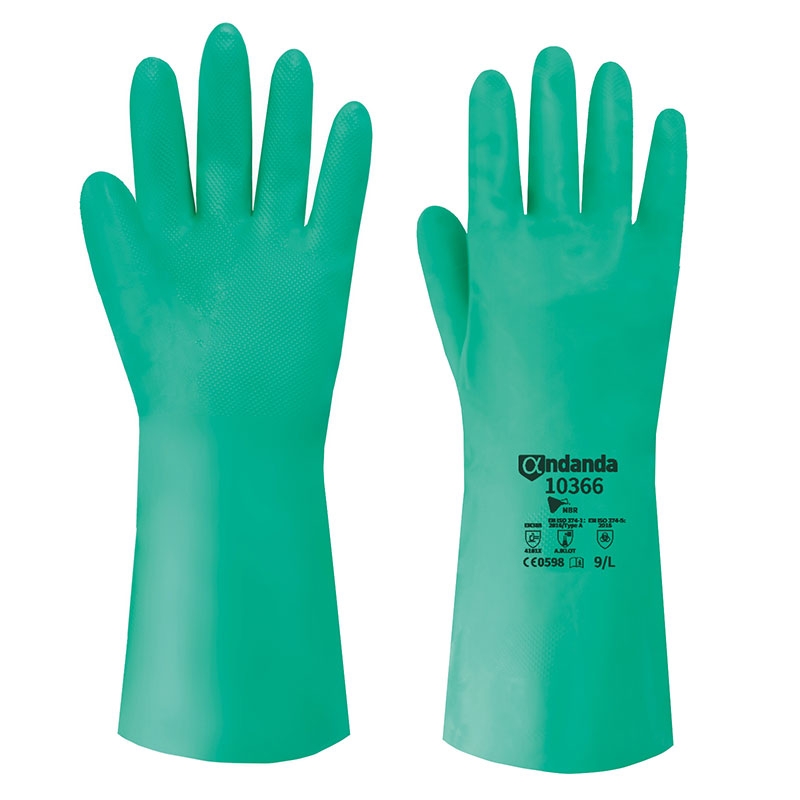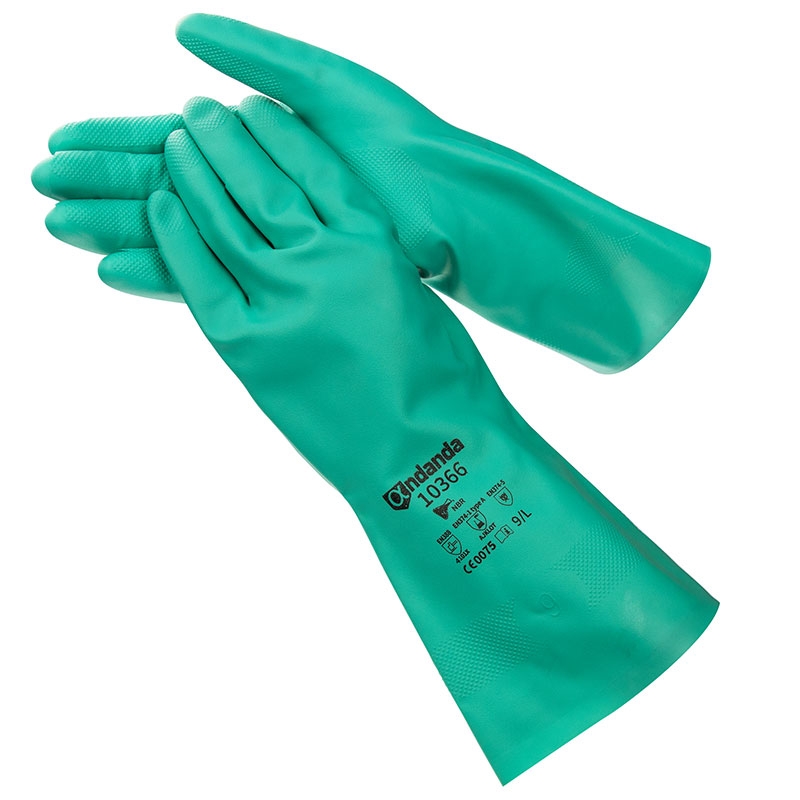Barrier Armor: Unlined Nitrile Chemical Protective Gloves
Unlined Nitrile Chemical Protective Gloves are essential personal protective equipment crafted to shield hands from various hazardous chemicals and substances. Composed of nitrile rubber, a substance renowned for its robust resistance to oils, fuels, and some solvents, these gloves are indispensable in environments where employees face exposure to dangerous chemicals. Their unlined design enhances the wearer’s flexibility and skill while minimizing the likelihood of allergic reactions often linked to latex gloves. These gloves’ critical role in upholding safety and hygiene standards in various fields, such as manufacturing, healthcare, and scientific research, cannot be emphasized enough. They are key to protecting the well-being of workers and ensuring the smooth operation of critical industries.

Features of Unlined Nitrile Gloves
Material Composition
Unlined Nitrile Gloves are constructed from Nitrile Butadiene Rubber (NBR), a material celebrated for its impressive flexibility and resistance to wear and tear. These gloves are specially designed with cotton fiber flocking, making them not only easy to put on and take off but also comfortable and efficient at absorbing sweat. This design consideration ensures that the gloves remain a practical choice for extended use in various industrial applications.
Durability and Chemical Resistance
One of the standout features of these gloves is their remarkable tolerance against a broad spectrum of chemicals. This includes exposure to alcohols, acids, alkalis, oils, and aldehydes, providing a versatile protective solution for workers in environments with diverse chemical hazards. Their robust build minimizes the risk of degradation upon contact with these substances, ensuring long-lasting protection.
Flexibility and Dexterity
To enhance user performance, these gloves boast a diamond texture design on the palm, significantly improving grip under various conditions. With a thickness of 0.38mm (15mil) and a length of 320mm, they strike an optimal balance between protection and dexterity, allowing for precise movements and handling of tools and materials without compromising safety.
Benefits of Using Unlined Nitrile Chemical Protective Gloves
Enhanced Safety
The primary benefit of these gloves is the high level of protection they offer against hazardous chemicals and substances. This safety feature is crucial in preventing occupational injuries and ensuring a safer working environment for individuals across multiple industries.
Allergy-Friendly
Designed with hypoallergenic materials, these gloves are a safe choice for individuals allergic to latex. This consideration broadens their applicability, ensuring that more workers can use them without the risk of allergic reactions.
Economic Efficiency
The durability of Unlined Nitrile Gloves translates into fewer replacements and, consequently, cost savings for businesses. Their long service life makes them an economical choice for companies looking to maintain high safety standards while managing operational costs effectively.
Applications of Unlined Nitrile Gloves
Industrial Use
Unlined Nitrile Gloves are indispensable in the manufacturing, automotive, and chemical industries, where workers frequently handle hazardous substances. These gloves provide a reliable barrier against a wide array of chemicals, ensuring worker safety during the production, handling, and maintenance processes.
Laboratory Use
In research, pharmaceutical, and academic laboratories, precision and protection are paramount. Unlined Nitrile Gloves meet these needs by offering excellent chemical resistance and dexterity, making them suitable for handling sensitive materials, conducting experiments, and performing intricate tasks that require a steady hand.
Healthcare Settings
These gloves are also crucial in healthcare environments for the handling of non-sterile materials and cleaning tasks. Their robust protection against chemicals and pathogens makes them a safe choice for healthcare professionals, ensuring a sterile environment and preventing cross-contamination.

Selection Guidelines
How to Choose the Right Size and Fit
Selecting the correct size and fit is essential for maximizing protection and comfort. Gloves should fit snugly without restricting movement. Most manufacturers offer a size chart, which can be used to find the appropriate size based on hand measurements.
Understanding Glove Thickness and Length
The thickness of the gloves, typically measured in mils (1 mil = 0.001 inches), affects their durability and sensitivity. Thicker gloves offer more protection but may reduce tactile sensitivity. The length of the gloves should be chosen based on the level of exposure risk, with longer gloves providing better protection against splashes.
Deciphering Glove Ratings and Chemical Resistance Charts
Glove ratings and chemical resistance charts are crucial tools for selecting the right gloves for specific chemicals. These ratings, based on standardized tests, provide information on the glove’s resistance to permeation and degradation by different chemicals. It’s important to consult these charts to ensure the gloves chosen will provide adequate protection against the substances being handled.
Usage and Maintenance
Proper Donning and Doffing Techniques
To maximize protection, it’s crucial to don and doff gloves correctly. Begin by ensuring hands are clean and dry. When putting on the gloves, do so gently to avoid tearing. To remove them, peel from the wrist towards the fingers to avoid skin contact with the contaminated outer surface. Dispose of or clean gloves appropriately after use.
Cleaning and Care Instructions
While unlined nitrile gloves are designed for single use in many cases, some can be cleaned and reused if not damaged. To clean, wash with mild soap and water and disinfect with suitable alcohol-based solutions if necessary. Thoroughly dry gloves before reuse. Note: Always follow manufacturer guidelines regarding glove reuse and cleaning.
Storage Recommendations to Prolong Life
Store gloves in a cool, dry place away from direct sunlight and heat sources, which can degrade nitrile rubber. Keep them in their original packaging to protect against contaminants and ensure they retain their protective properties until use.
Limitations and Precautions
Situations Where Unlined Nitrile Gloves Should Not Be Used
Despite their versatility, unlined nitrile gloves are not suitable for all chemicals or temperatures. They may not provide sufficient protection against certain strong solvents or highly corrosive acids. Always consult chemical resistance charts before use.
Recognizing Signs of Wear and Tear
Regularly inspect gloves for signs of damage such as cracks, punctures, or significant wear, particularly in high-contact areas. Damaged gloves provide reduced protection and should be replaced immediately to ensure safety.
Understanding Chemical Breakthrough Times
Breakthrough time is the duration a glove can resist chemical penetration. Different chemicals will permeate gloves at different rates. Familiarize yourself with the breakthrough times for the chemicals you are handling to ensure you are changing the gloves often enough to maintain protection.
Choose Andanda’s Unlined Nitrile Chemical Protective Gloves Today!
Unlined Nitrile Chemical Protective Gloves stand as a pivotal element in ensuring safety across a wide range of industries, from manufacturing to healthcare. Their unique composition offers unmatched durability, chemical resistance, and flexibility, making them an essential protective measure for workers handling hazardous substances. By adhering to proper usage, and maintenance guidelines and understanding their limitations, users can significantly mitigate the risks associated with chemical exposure. As the backbone of personal protective equipment, Andanda’s gloves not only protect individuals but also underline the importance of maintaining stringent safety standards in the workplace. Ensuring the right selection and application of these gloves is crucial for safeguarding health and promoting a safe working environment for everyone.

